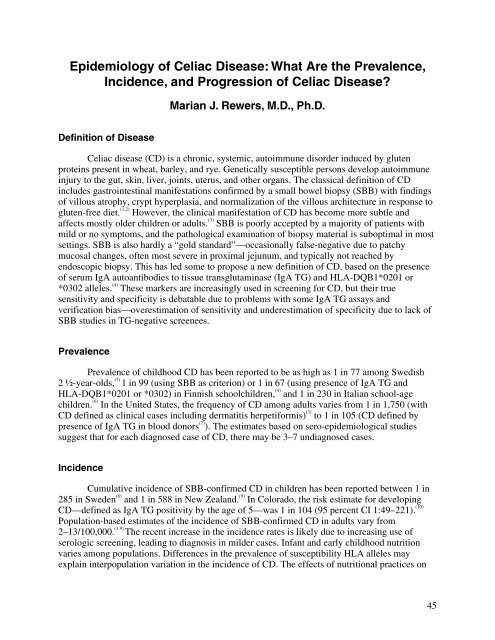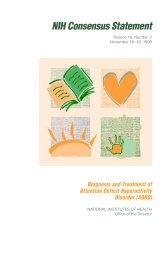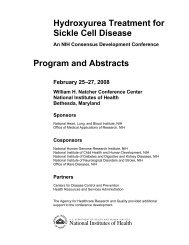Epidemiology of <strong>Celiac</strong> <strong>Disease</strong>: What Are the Prevalence,Incidence, and Progression of <strong>Celiac</strong> <strong>Disease</strong>?Marian J. Rewers, M.D., Ph.D.Definition of <strong>Disease</strong><strong>Celiac</strong> disease (CD) is a chronic, systemic, autoimmune disorder induced by glutenproteins present in wheat, barley, and rye. Genetically susceptible persons develop autoimmuneinjury to the gut, skin, liver, joints, uterus, and other organs. The classical definition of CDincludes gastrointestinal manifestations confirmed by a small bowel biopsy (SBB) with findingsof villous atrophy, crypt hyperplasia, and normalization of the villous architecture in response togluten-free diet. (1,2) However, the clinical manifestation of CD has become more subtle andaffects mostly older children or adults. (3) SBB is poorly accepted by a majority of patients withmild or no symptoms, and the pathological examination of biopsy material is suboptimal in mostsettings. SBB is also hardly a “gold standard”—occasionally false-negative due to patchymucosal changes, often most severe in proximal jejunum, and typically not reached byendoscopic biopsy. This has led some to propose a new definition of CD, based on the presenceof serum IgA autoantibodies to tissue transglutaminase (IgA TG) and HLA-DQB1*0201 or*0302 alleles. (4) These markers are increasingly used in screening for CD, but their truesensitivity and specificity is debatable due to problems with some IgA TG assays andverification bias—overestimation of sensitivity and underestimation of specificity due to lack ofSBB studies in TG-negative screenees.PrevalencePrevalence of childhood CD has been reported to be as high as 1 in 77 among Swedish2 ½-year-olds, (5) 1 in 99 (using SBB as criterion) or 1 in 67 (using presence of IgA TG andHLA-DQB1*0201 or *0302) in Finnish schoolchildren, (4) and 1 in 230 in Italian school-agechildren. (6) In the United States, the frequency of CD among adults varies from 1 in 1,750 (withCD defined as clinical cases including dermatitis herpetiformis) (3) to 1 in 105 (CD defined bypresence of IgA TG in blood donors (7) ). The estimates based on sero-epidemiological studiessuggest that for each diagnosed case of CD, there may be 3–7 undiagnosed cases.IncidenceCumulative incidence of SBB-confirmed CD in children has been reported between 1 in285 in Sweden (8) and 1 in 588 in New Zealand. (9) In Colorado, the risk estimate for developingCD—defined as IgA TG positivity by the age of 5—was 1 in 104 (95 percent CI 1:49–221). (10)Population-based estimates of the incidence of SBB-confirmed CD in adults vary from2–13/100,000. (3,9) The recent increase in the incidence rates is likely due to increasing use ofserologic screening, leading to diagnosis in milder cases. Infant and early childhood nutritionvaries among populations. Differences in the prevalence of susceptibility HLA alleles mayexplain interpopulation variation in the incidence of CD. The effects of nutritional practices on45
the risk and severity of CD may also account for geographic and temporal variation in theincidence of CF and may be of great public health importance.ProgressionWhile there is growing evidence for a remitting-relapsing pattern of CD autoimmunity insome patients, (4,11) the disease process defined by current serological and histopathologicaltechniques is remarkably persistent in the absence of gluten-free diet. A two- to threefold excessin all-cause mortality among CD patients, compared to the general population, has been reportedin some studies (12,13) and attributed to GI tract malignancies. (14,15)In summary, CD is a protean systemic disease affecting up to 1 percent of the generalpopulation. Appropriate screening, diagnosis, and treatment guidelines are being redefined usingimproved diagnostic methods that include IgA TG testing and HLA-DQB1 typing, in addition toSBB.References1. Walker-Smith J, Guandalini S, Schmitz J, Shmerling D, Visakorpi J. Revised criteria fordiagnosis of coeliac disease. Report of Working Group of European Society of PaediatricGastroenterology and Nutrition. Arch Dis Child. 1990;65:909–911.2. Catassi C, Cellier C, Cerf-Bensussan N, et al. When is a coeliac a coeliac? Report of aworking group of the United European Gastroenterology Week in Amsterdam. EuropeanJournal of Gastroenterology & Hepatology. 2001;13:1123–1128.3. Murray JA, Van Dyke C, Plevak MF, Dierkhising RA, Zinsmeister AR, Melton LJ, III.Trends in the identification and clinical features of celiac disease in a North Americancommunity, 1950–2001. Clin Gastroenterol Hepatol. 2003;1:19–27.4. Maki M, Mustalahti K, Kokkonen J, et al. Prevalence of celiac disease among children inFinland. N Engl J Med. 2003;348:2517–2524.5. Carlsson A, Axelsson I, Borulf S, et al. Prevalence of IgA-antigliadin antibodies andIgA-antiendomysium antibodies related to celiac disease in children with Down syndrome.Pediatrics. 1998;101:272–275.6. Catassi C, Ratsch IM, Fabiani E, et al. High prevalence of undiagnosed coeliac disease in5280 Italian students screened by antigliadin antibodies. Acta Paediatr. 1995;84:672–676.7. Fasano A, Berti I, Gerarduzzi T, et al. Prevalence of celiac disease in at-risk and not-at-riskgroups in the United States: A large multicenter study. Arch Intern Med. 2003;163:286–292.8. Cavell B, Stenhammar L, Ascher H, et al. Increasing incidence of childhood coeliac diseasein Sweden. Results of a national study. Acta Paediatr. 1992;81:589–592.46
- Page 1 and 2: NIH Consensus Development Conferenc
- Page 3 and 4: III. What Are the Manifestations an
- Page 5 and 6: • What is the management of celia
- Page 7 and 8: Monday, June 28, 2004 (continued)I.
- Page 9 and 10: Monday, June 28, 2004 (continued)II
- Page 11 and 12: Wednesday, June 30, 2004 (continued
- Page 13 and 14: Lisa H. RichardsonConsumer Represen
- Page 15 and 16: Ciaran P. Kelly, M.D.Director, Celi
- Page 17 and 18: Van S. Hubbard, M.D., Ph.D.Director
- Page 19 and 20: AbstractsThe following are abstract
- Page 21 and 22: susceptibility (e.g., DR17 homozygo
- Page 23 and 24: The Pathology of Celiac DiseaseDavi
- Page 25 and 26: In this regard, the transport pathw
- Page 27 and 28: for the IgG-based test, while speci
- Page 29 and 30: 15. de Lecea A, Ribes-Koninckx C, P
- Page 31 and 32: Clinical Algorithm in Celiac Diseas
- Page 33 and 34: Considera diagnosisof celiac diseas
- Page 35 and 36: There are populations at particular
- Page 37 and 38: Serological Testing for Celiac Dise
- Page 39: Estimates of the sensitivity of the
- Page 43 and 44: What Are the Prevalence and Inciden
- Page 45 and 46: ascribed to excess menstrual loss.
- Page 47 and 48: ReferencesFamily History of Celiac
- Page 49 and 50: Carroccio A, Iannitto E, Cavataio F
- Page 51 and 52: identified by surveys or through so
- Page 53 and 54: Clinical Presentation of Celiac Dis
- Page 55 and 56: een widely reported. The question r
- Page 57 and 58: The Many Faces of Celiac Disease: C
- Page 59 and 60: References1. Green PH, Jabri B. Coe
- Page 61 and 62: Association of Celiac Disease and G
- Page 63 and 64: Does the Gluten-Free Diet Protect F
- Page 65 and 66: Skin Manifestations of Celiac Disea
- Page 67 and 68: allow a better understanding of the
- Page 69 and 70: 4. Henriksson KG, Hallert C, Walan
- Page 71 and 72: characterized, clinically-identifie
- Page 73 and 74: 10. Hoffenberg EJ, Emery LM, Barrig
- Page 75 and 76: ataxia, epilepsy with posterior cer
- Page 77 and 78: Consequences of Testing for Celiac
- Page 79 and 80: Osteoporosis/FracturesThere were 11
- Page 81 and 82: Dietary Guidelines for Celiac Disea
- Page 85 and 86: 21. Thompson T. Thiamin, riboflavin
- Page 88 and 89: In order to effectively counsel ind
- Page 90 and 91:
9. Hallert C, Granno C, Hulten S, M
- Page 92 and 93:
adhered to the GFD after more than
- Page 94 and 95:
Patient education, close supervisio
- Page 96:
26. Mustalahti K, Lohiniemi S, Laip







